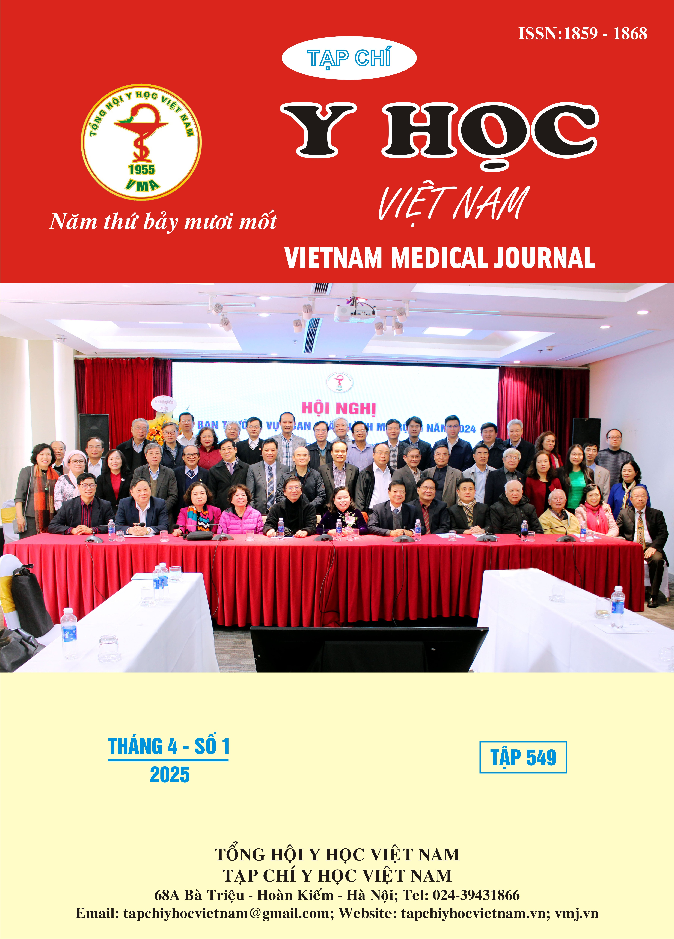STUDY ON THE CHARACTERISTICS OF THE ACTIVE PHASE OF LABOR AND PREGNANCY OUTCOMES IN FULL-TERM PREGNANT WOMEN AT CAN THO OBSTETRICS AND GYNECOLOGY HOSPITAL
Main Article Content
Abstract
Objectives: To describe the characteristics of the active phase of labor, investigate related factors, and assess pregnancy outcomes in full-term pregnant women at Can Tho Obstetrics and Gynecology Hospital in 2023–2024. Materials and methods: A cross-sectional descriptive study was conducted on 196 full-term pregnant women in the active phase of labor admitted to Can Tho Obstetrics and Gynecology Hospital from March 2023 to April 2024. Results: The average maternal age was 28.53 ± 5.17 years. The mean body mass index (BMI) was 21.1 ± 2.7 kg/m². The amniotic membrane remained intact in 60.7% of cases, while 39.3% experienced rupture of membranes. The average time for cervical dilation of 1 cm was 32.91 ± 23.65 minutes in vaginal deliveries and 116.10 ± 94.83 minutes/cm in cesarean deliveries. Fetal station distribution: 21.9% were unengaged, while 78.1% had fetal stations ranging from 0 to +2. Cervical edema was observed in 32.1%, while 67.9% had no edema. The anterior fetal position was present in 83.2%, while 16.8% were in posterior or transverse positions. The average cervical dilation time from 3 to 5 cm was 180.21 ± 134.66 minutes, and from 5 to 10 cm was 166.60 ± 117.35 minutes. Regarding pregnancy outcomes, 74.0% had vaginal deliveries, while 26.0% underwent cesarean sections. Cesarean deliveries at 4 cm cervical dilation accounted for 7.8% of cases. Postpartum complications included hemorrhage (1.0%), genital tract injury (0.5%), and infection (0.5%). The average neonatal birth weight was 3,116.94 ± 351.15 g. Neonatal unit admissions occurred in 5.1% of cases due to respiratory distress (3.1%), infection (1%), and birth trauma (1%). Conclusion: The mean time for cervical dilation from 3 to 5 cm was 180.21 minutes, longer than the time from 5 to 10 cm (166.60 minutes). Cesarean sections performed at 4 cm cervical dilation accounted for only 7.8% of cases. Factors associated with pregnancy outcomes included parity, membrane status (intact or ruptured), cervical edema, and fetal position.
Article Details
Keywords
Active phase of labor, primiparous, multiparous
References
2. The American College of Obstetricians and Gynecologists. ACOG Practice bulletin No. 115: Vaginal birth after cesarean delivery. Archives of medical research. 2020. 116(2), p. 450-463.
3. WHO. WHO recommendations: Intrapartum care for a positive childbirth experience. 2018.
4. Louise Lundborg, et al. First stage progression in women with spontaneous onset of labor: A large population-based cohort study. Indian journal of endocrinology metabolism. 2020. 15(9), p. e0239724
5. Lê Thị Thuỳ Dung. Nghiên cứu đặc điểm lâm sàng, cận lâm sàng và một số yếu tố liên quan của mổ lấy thai nhóm III theo phân loại của Robson tại Bệnh viện đa khoa Trung ương Cần Thơ. Luận văn chuyên khoa cấp II, ĐHYD Cần Thơ. 2021. Tr: 48-62.
6. Nguyễn Thị Huyền Trang. Đặc điểm chuyển dạ của các trường hợp mổ lấy thai vì chuyển dạ đình trệ tại bệnh viện Quân Y 175. Tạp chí Y học TP. Hồ Chí Minh. 2021. 25.
7. Oladapo OT, et al. Progression of the first stage of spontaneous labour: A prospective cohort study in two sub-Saharan African countries. PLoS medicine. 2018. 15(1), p. e1002492
8. Nguyễn Quốc Tuấn (2023). Nghiên cứu tình hình, một số yếu tố liên quan đến mổ lấy thai và kết cục thai kỳ ở sản phụ con so đủ tháng tại Bệnh viện Phụ sản thành phố Cần Thơ năm 2022-2023. Luận văn chuyên khoa cấp II, Trường ĐHYD Cần Thơ. Tr 43-53.


